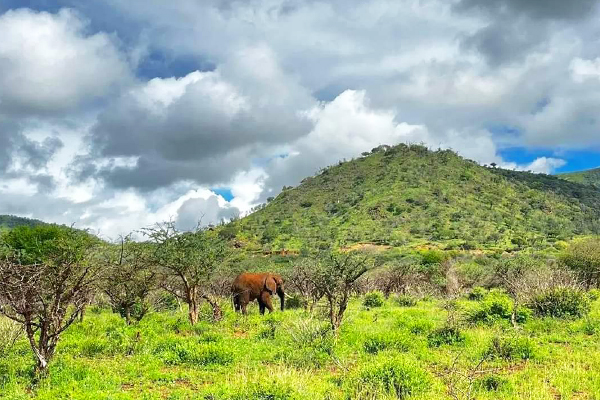MKOMAZI NATIONAL PAARK
Mkomazi National Park
A beautiful park with an amazing history
Mkomazi National Park is less famous for its wildlife than for its overwhelming beauty. In the north-west you can experience breathtaking views of Mount Kilimanjaro, and in the south you can see the Pare and Usambara mountains. The huge Tsavo National Park in Kenya borders the park. Together they form a large and important ecosystem in which numerous animals roam freely. But a closer look reveals a remarkable history of habitat and animal conservation, including the reintroduction of two endangered species – the black rhino and the African wild dog.
A tragic to success story
Mkomazi National Park is located in northern Tanzania between the cities of Moshi and Tanga. The park is located in beautiful surroundings, framed by the Pare and Usambara Mountains. Depending on the weather, the view extends as far as Mount Kilimanjaro.
Visitors to Mkomazi National Park experience something unique. The park may have a smaller animal population than other parks, but it is a quiet and little-visited place with exceptionally beautiful landscapes and a fascinating history.
In 1951, the Mkomazi was declared a game reserve. However, this could not prevent the chaos that was to follow. Persistent poaching led to the black rhino disappearing from the landscape and the elephant population dropping to 11 animals. At the same time, intensive grazing and annual fires led to extreme land degradation. A natural disaster was in the making.
The year 1989 marked a decisive turning point in the history of the Mkomazi. The Tanzanian government intervened and commissioned the George Adamson Wildlife Preservation Trusts (GAWPT) to restore the reserve and reintroduce the black rhino and African wild dog. The project was led by Tony Fitzjohn, the successor to George Adamson (Born Free).
Over the years, Tony and his team laid many kilometres of roads, fences and water systems. A ranger team and an air force unit began patrolling the park to combat ivory poaching, while breeding programmes for wild dogs and black rhino were established. It was a mammoth task. At the same time, it was important to involve the local population. Several projects were launched, including “Rafiki wa Faru” (Friends of the Rhinos), which introduces schoolchildren to the park’s conservation work.
Today, over 500 elephants are counted in Mkomazi and more than 200 wild dogs roam freely in the park. Mkomazi National Park is home to eland, zebra, buffalo, hartebeest, giraffe, warthog and is also worth a visit for those who want to see large herds of oryx and giraffe gazelle roaming the open bushveld. Other large and small mammals represented here include lions, leopards, cheetahs, hyenas and jackals. However, sightings of the larger predators are rarer.
A total of 450 bird species are native to the national park and you will see some of them on your game drive. The most common sightings are of grey-legged birds, ostriches, crested eagles, hoopoes and bustards. Kingfishers, flamingos, cormorants, plovers and ducks can be observed on the Umba River.
Best time to visit Mkomazi National Park
You can visit Mkomazi National Park all year round. Perhaps the best time to visit Mkomazi National Park is during the dry season from June to October. This is when the weather and game viewing are at their best. June is the coolest month and October the warmest.
The Umba River in the south-east corner of the park is the only river in the region. Animals can be spotted here during the dry season. The park authorities have built a dam that creates several waterholes in different areas of the park so that the animals can find water during the dry season.
Undiscovered and underrated
We could very well imagine you leaving Mkomazi National Park with the resolution that you definitely want to come back. With few people visiting, Mkomazi offers what many would describe as an exclusive safari experience amidst beautiful landscapes.
Yes, the number of animals here is lower than elsewhere, but thanks to ongoing conservation efforts, this could soon change. In the late 1980s, there were only 11 elephants in the park. Today, over 500 elephants move back and forth between Tsavo and Mkomazi. And if you visit the rhino visitor centre, a black rhino sighting is guaranteed.
Location
Mkomazi Park is only 252 km from Arusha and 172 km from Moshi and can be reached by road. The rhino visitor centre is not far from Zange Gate, while the rhino sanctuary is close to Njiro Gate. Most accommodation is located at Zange Gate, the river is in the south-east corner of the park. During your stay, you can also visit the Pare and Usambara Mountains in the south of the park and go on unforgettable hikes.
Photos from Mkomazi National Park




INQUIRE MKOMAZI NATIONAL PARK TOUR
Start planning your Mkomazi National Park tour by filling the form below
